Special-purpose audio gadget: Dictograph - from the workshop and the opera to the first wiretap, a technical masterpiece from 1907
The beginning of the widespread use of listening devices in operational and investigative work in the mass consciousness is associated with 30s, in rare cases 20s of the last century. In reality, special means for listening appeared, were actively and effectively used before the First World War.

photo vintage-technics.ru
In this post we will talk about the unique for its time, but rather common device Dictograph (as well as its variant for covert listening, known as Detective Dictograph). This audio gadget was probably the first serial selector communicator, the first device for covert listening, as well as the first electronic special tool that made it possible to obtain data recognized as evidence in court. Under the cat a story about the first “bug”, its creation, practice and opportunities.
The history of the device begins in 1903, when the laboratory of the American company General Acoustics Company, its president Kelly Monroe Turner begins the development of a highly sensitive carbon microphone. He completes the work on the microphone in 1907. Then he and Donnan, the company's CFO, open a special division of General Acoustics - Dictograph Products Inc.
 Kelly Monroe Turner The
Kelly Monroe Turner The
technical feature of this device, later called the Metrophone, was a large-area diaphragm, thanks to which the microphone captured the sound waves of a human speech range at a distance of about 1.5 meters.
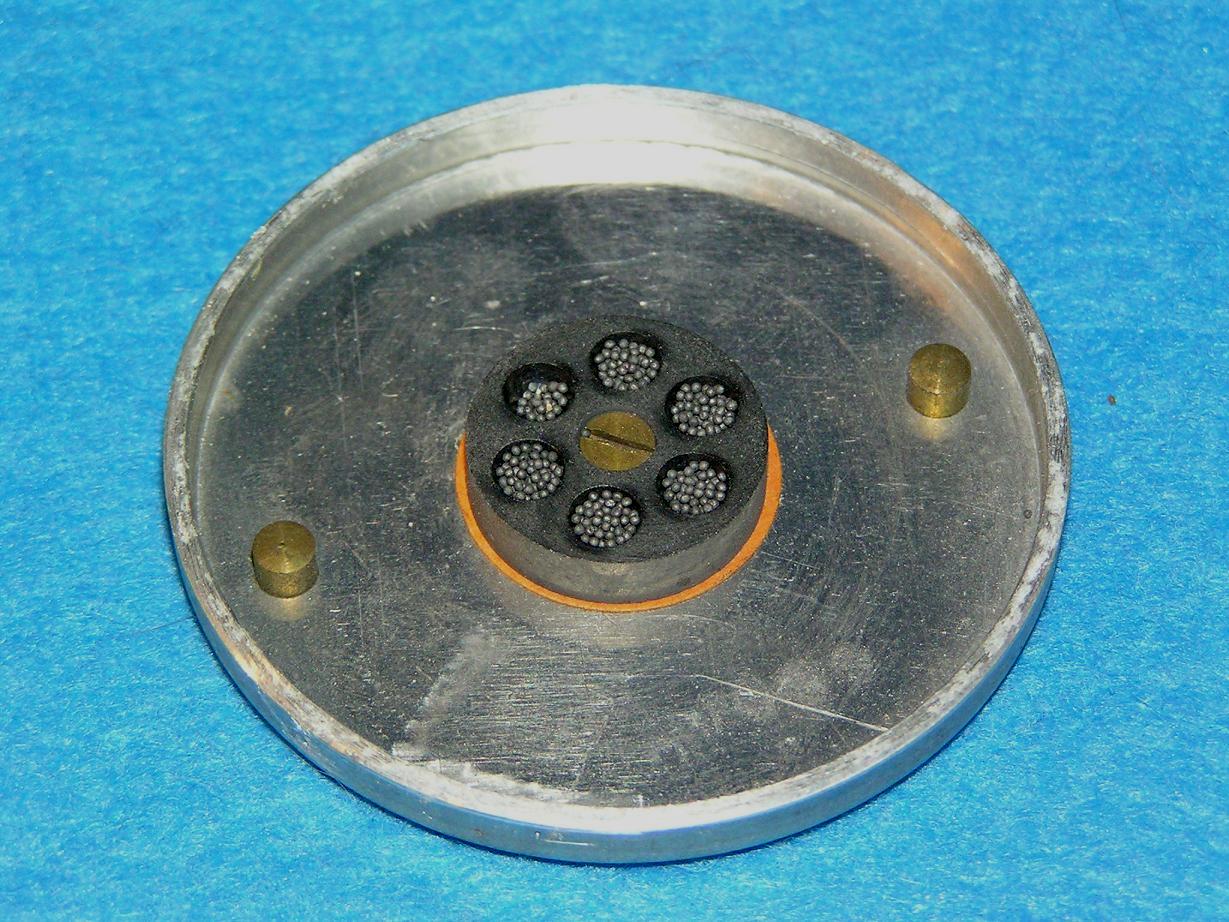
Metrophone sector device - cameras filled with coal
This development served as the basis for several devices at once, such as the Acousticon hearing aid, telephone and intercom. It was the intercom system, which also included a desktop loudspeaker and headphones, that was later converted into a special device.

Internal communication with dictographers gained limited popularity in New York. The stationary system, which included desktop equipment, loudspeakers for workshops and other elements, was manufactured by the Turner plant and in the first years of production hardly met the demand of industrial giants of the growing city of skyscrapers.
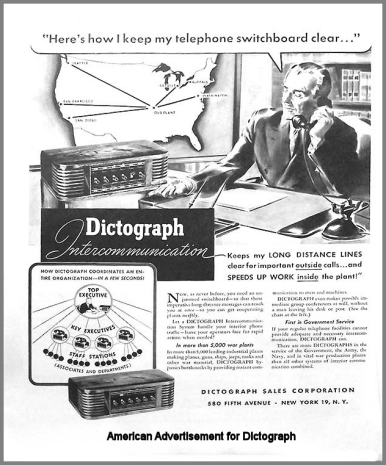
However, industrial giants were soon over, and other enterprises were satisfied with classic telephones and did not want to buy a dictograph, which required complex and expensive switching from each communication node. Due to the low demand for communication systems, Dictograph Products Inc entered into an agreement with Lamson Engineering, which helped them to lease it instead of selling the device. Thus, by 1908, the rent of a dial-up dictographic communication system, which included one master console and five stations, cost only five dollars and fifty cents a month.
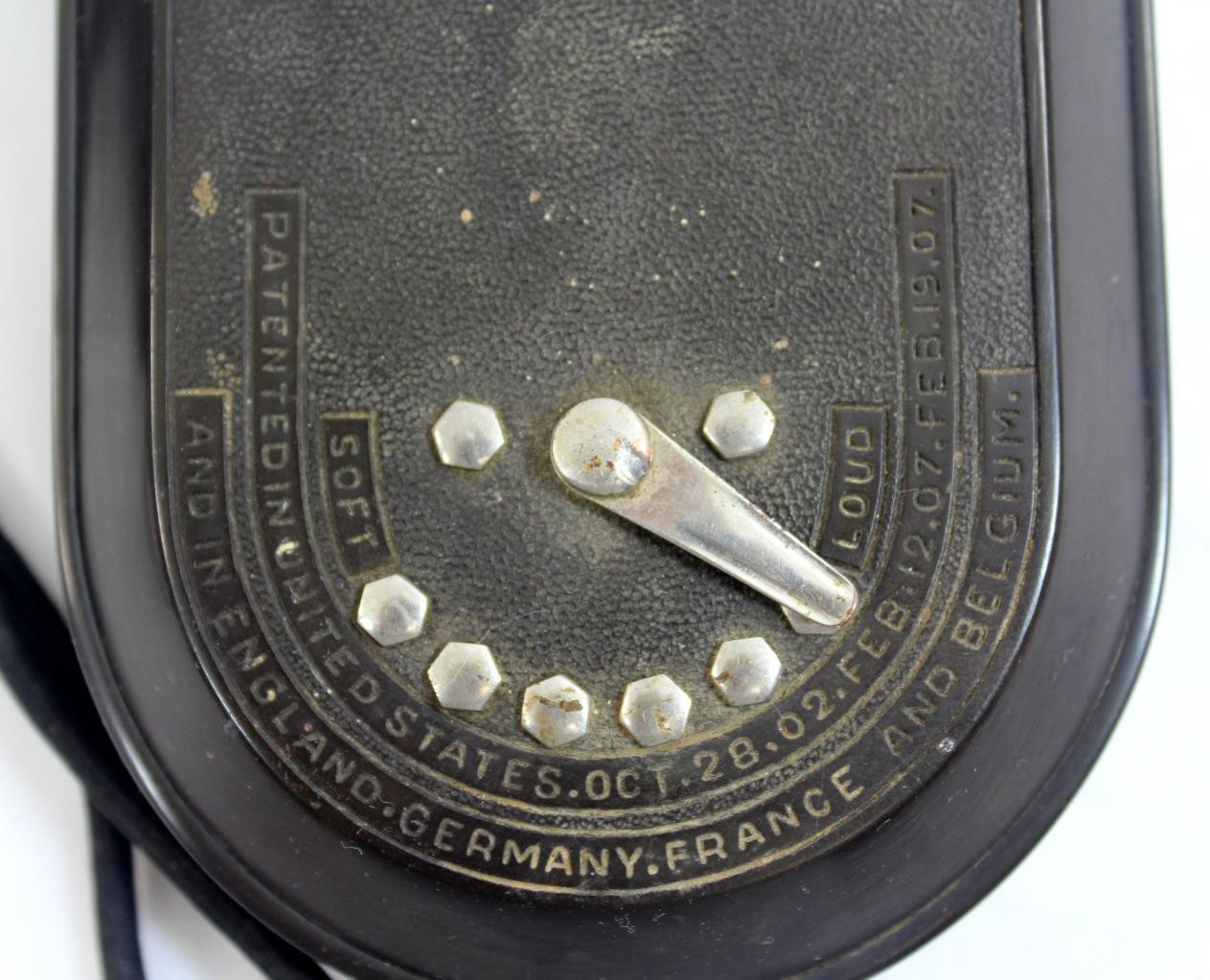
Particularly noteworthy marketing activities Turner. So the dictograph microphone blocks were used for radio broadcasting of the opera Lee De Forrest in New York in 1910. The very fact of the broadcast and the equipment used for this were widely reported in the technical press, which made a serious advertising to the dictograph. Also, since its appearance on the market, the dictograph's advertisement has been regularly published in Popular Mechanics magazine.

The rental strategy met expectations, but brought less money than planned to receive from sales and installation of turnkey systems, which forced Turner to look for options for marketing ready-made systems. Despite failures in financial planning, at the end of 1908 - 1909, the company's position was strengthened due to three circumstances.

The first is a large government order that allowed Turner to open another production facility in Chicago. The second is orders from European subsidiaries, which were opened in the UK, France, and Germany in 1907. Third - the emergence of high demand for a portable version of the dictograph from the special services and private detective agencies.
According to various sources, a portable version of the dictograph appeared either in 1907 or in 1910. It is known for certain that in 1910, the portable version of the device was called the Detective Dictograph. According to the information that has reached us, the device was widely used by special services and private agencies all over the world until the mid-20s, when more miniature options appeared for organizing wiretapping.
Detective Dictograph was a set of portable equipment (2 pairs of headphones, a switch, connection cables, alkaline batteries), which provides work with 2 “Metrophone” microphones. What is interesting, for the special gadget version was used, which was larger in size, since the increase in sensitivity was achieved by increasing the area of the membrane.

The design of the microphone, in addition to increasing the membrane area, has not undergone significant changes, while special loops were added for attaching the gadget to clothing, during latent listening.

I would venture to suggest that already in those years (judging by the bold publications in Popular Mechanics), the possibility was considered of using the device together with a phonograph to record conversations, but there is no information about the facts of such use and the corresponding specifications in the instructions for the device.
It should be noted that for its time the device was very portable. The mass of the kit with batteries and case was only 2.3 kg. with overall dimensions of 335 x 200 x 85 mm.
Microphones are presented in two sizes - portable and stationary. Dimensions of a stationary rectangular microphone 85 x 85 x 25 mm, weight 135 g.

A portable round microphone weighs only 70 g with dimensions of 58 x 20 mm.

Both microphones have a resistance of 500 ohms.
Judging by the characteristics indicated in the passport of the device kit, the original batteries lasted for 15 minutes of continuous listening.
An interesting feature is the sector volume control built into the switch.
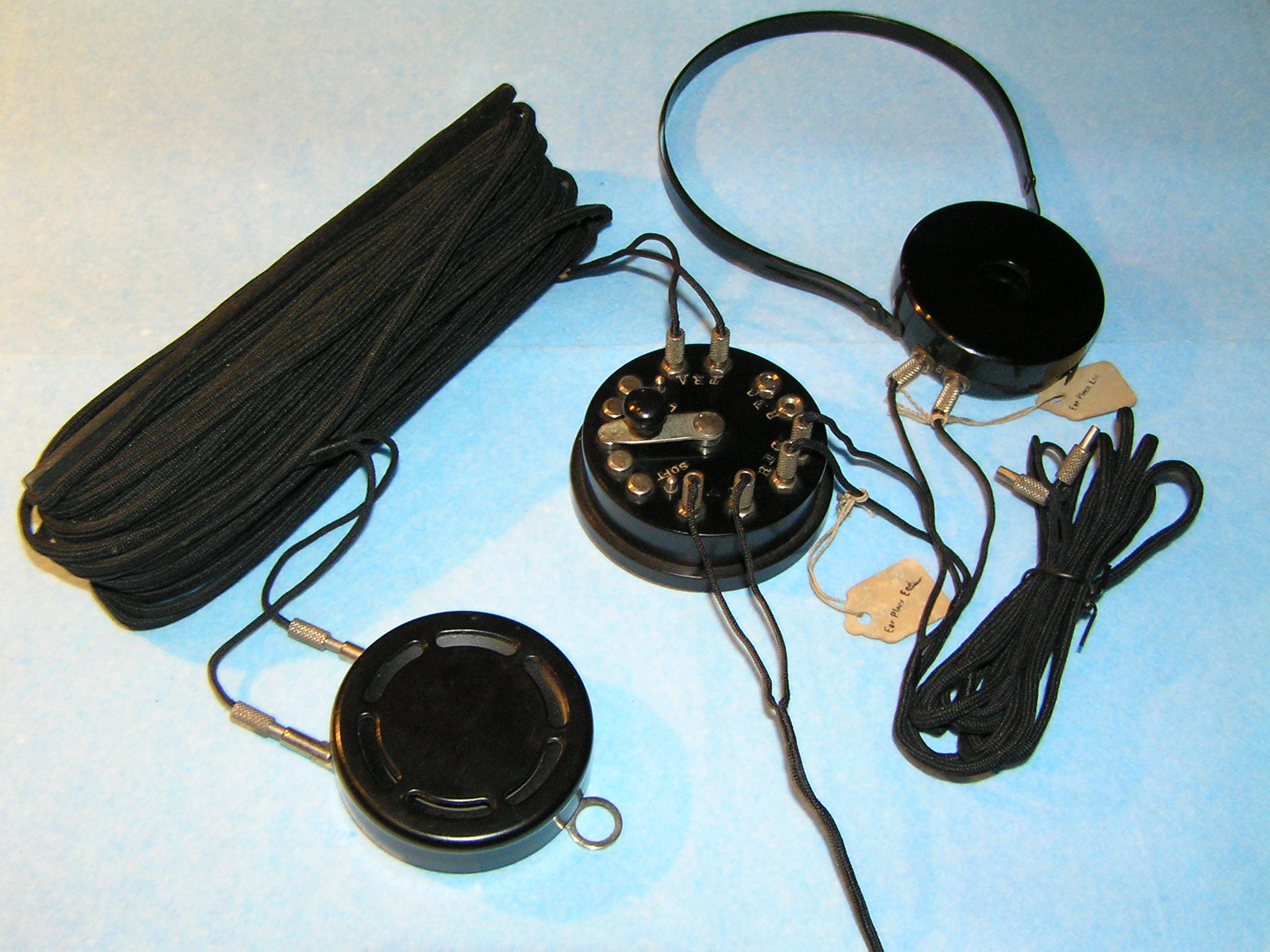
Quickly enough, Detective Dictograph, which at the time of the appearance of $ 126 (two monthly earnings of the average American), became popular with the special services of the USA and Europe, police, and detective agencies. We know at least one agency in the United States that used the data obtained with the help of a dictograph in court - this is the Burns agency.

There is evidence that one of the first cases where data from “scientific dictation” was used in the evidence was one of the first terrorist attacks in the United States — an explosion in the Los Angeles Times building. It is also known that the courts agreed to accept as evidence evidence (as a rule, a transcript) obtained with the help of a dictograph. There is information about the use of dictographers Schindler Bureau of Investigation, Pinkerton Agency, as well as the people of William J. Flynn.
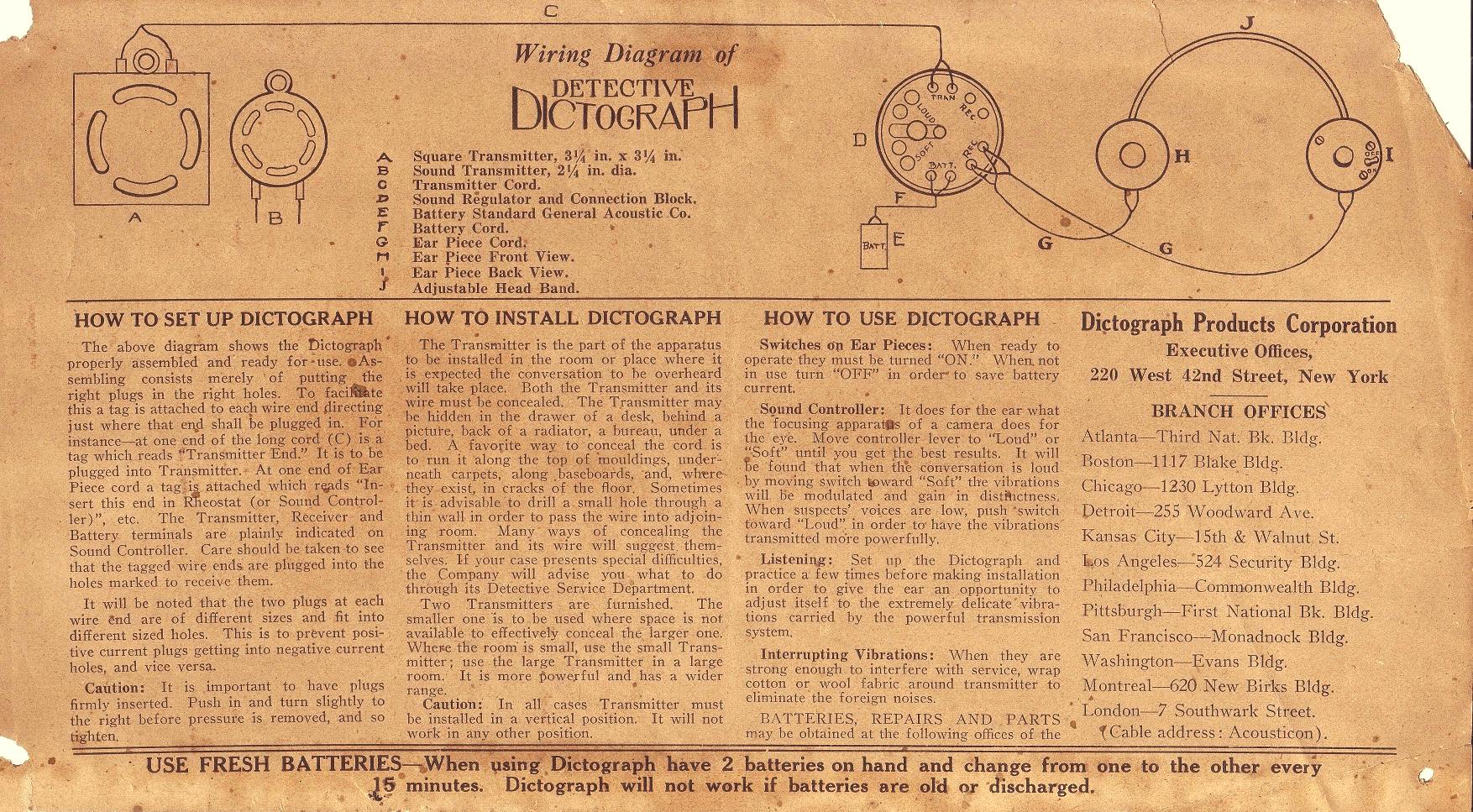
In one of the advertising publications about the dictograph, a presentation of the device is described, on which the listener managed to hear the rustle of the clothes of a journalist who was approaching the microphone. Such information, as well as the use of the device in the practice of special services, made the name of the device and significantly stimulated its sales. By analogy with selector communication, the special gadget began to be leased. In 1910, a month of Detective Dictograph cost $ 1 more than its stationary counterpart (ie, $ 6).
The history of the dictograph and his creator Turner show that some ideas may find unexpected uses. Developed as a communications system for enterprises, dictographs held out on this market for about 10 years and were significantly inferior in popularity to their portable version for special services, which was in demand until the mid-20s. In the future, on the basis of this development, new models of phones, wireless communication systems, special communication systems for the US Army appeared. The company Turner, who died in 1927, being not a poor and respected person, exists to this day and is engaged in security systems.
Used photos of vintage-technics.ru
Jeans
In our catalog There is no special equipment, but there are UMZCH, acoustic systems, DAC, headphones and other high-fidelity audio equipment.

photo vintage-technics.ru
In this post we will talk about the unique for its time, but rather common device Dictograph (as well as its variant for covert listening, known as Detective Dictograph). This audio gadget was probably the first serial selector communicator, the first device for covert listening, as well as the first electronic special tool that made it possible to obtain data recognized as evidence in court. Under the cat a story about the first “bug”, its creation, practice and opportunities.
The Turner brainchild
The history of the device begins in 1903, when the laboratory of the American company General Acoustics Company, its president Kelly Monroe Turner begins the development of a highly sensitive carbon microphone. He completes the work on the microphone in 1907. Then he and Donnan, the company's CFO, open a special division of General Acoustics - Dictograph Products Inc.

technical feature of this device, later called the Metrophone, was a large-area diaphragm, thanks to which the microphone captured the sound waves of a human speech range at a distance of about 1.5 meters.

Metrophone sector device - cameras filled with coal
This development served as the basis for several devices at once, such as the Acousticon hearing aid, telephone and intercom. It was the intercom system, which also included a desktop loudspeaker and headphones, that was later converted into a special device.

Market conquest
Internal communication with dictographers gained limited popularity in New York. The stationary system, which included desktop equipment, loudspeakers for workshops and other elements, was manufactured by the Turner plant and in the first years of production hardly met the demand of industrial giants of the growing city of skyscrapers.

However, industrial giants were soon over, and other enterprises were satisfied with classic telephones and did not want to buy a dictograph, which required complex and expensive switching from each communication node. Due to the low demand for communication systems, Dictograph Products Inc entered into an agreement with Lamson Engineering, which helped them to lease it instead of selling the device. Thus, by 1908, the rent of a dial-up dictographic communication system, which included one master console and five stations, cost only five dollars and fifty cents a month.

Particularly noteworthy marketing activities Turner. So the dictograph microphone blocks were used for radio broadcasting of the opera Lee De Forrest in New York in 1910. The very fact of the broadcast and the equipment used for this were widely reported in the technical press, which made a serious advertising to the dictograph. Also, since its appearance on the market, the dictograph's advertisement has been regularly published in Popular Mechanics magazine.

The rental strategy met expectations, but brought less money than planned to receive from sales and installation of turnkey systems, which forced Turner to look for options for marketing ready-made systems. Despite failures in financial planning, at the end of 1908 - 1909, the company's position was strengthened due to three circumstances.

The first is a large government order that allowed Turner to open another production facility in Chicago. The second is orders from European subsidiaries, which were opened in the UK, France, and Germany in 1907. Third - the emergence of high demand for a portable version of the dictograph from the special services and private detective agencies.
Detective Dictograph - friend of the detective, the enemy of the spy
According to various sources, a portable version of the dictograph appeared either in 1907 or in 1910. It is known for certain that in 1910, the portable version of the device was called the Detective Dictograph. According to the information that has reached us, the device was widely used by special services and private agencies all over the world until the mid-20s, when more miniature options appeared for organizing wiretapping.
Detective Dictograph was a set of portable equipment (2 pairs of headphones, a switch, connection cables, alkaline batteries), which provides work with 2 “Metrophone” microphones. What is interesting, for the special gadget version was used, which was larger in size, since the increase in sensitivity was achieved by increasing the area of the membrane.

The design of the microphone, in addition to increasing the membrane area, has not undergone significant changes, while special loops were added for attaching the gadget to clothing, during latent listening.

I would venture to suggest that already in those years (judging by the bold publications in Popular Mechanics), the possibility was considered of using the device together with a phonograph to record conversations, but there is no information about the facts of such use and the corresponding specifications in the instructions for the device.
It should be noted that for its time the device was very portable. The mass of the kit with batteries and case was only 2.3 kg. with overall dimensions of 335 x 200 x 85 mm.
Microphones are presented in two sizes - portable and stationary. Dimensions of a stationary rectangular microphone 85 x 85 x 25 mm, weight 135 g.

A portable round microphone weighs only 70 g with dimensions of 58 x 20 mm.

Both microphones have a resistance of 500 ohms.
Judging by the characteristics indicated in the passport of the device kit, the original batteries lasted for 15 minutes of continuous listening.
An interesting feature is the sector volume control built into the switch.

Practical use
Quickly enough, Detective Dictograph, which at the time of the appearance of $ 126 (two monthly earnings of the average American), became popular with the special services of the USA and Europe, police, and detective agencies. We know at least one agency in the United States that used the data obtained with the help of a dictograph in court - this is the Burns agency.

There is evidence that one of the first cases where data from “scientific dictation” was used in the evidence was one of the first terrorist attacks in the United States — an explosion in the Los Angeles Times building. It is also known that the courts agreed to accept as evidence evidence (as a rule, a transcript) obtained with the help of a dictograph. There is information about the use of dictographers Schindler Bureau of Investigation, Pinkerton Agency, as well as the people of William J. Flynn.

In one of the advertising publications about the dictograph, a presentation of the device is described, on which the listener managed to hear the rustle of the clothes of a journalist who was approaching the microphone. Such information, as well as the use of the device in the practice of special services, made the name of the device and significantly stimulated its sales. By analogy with selector communication, the special gadget began to be leased. In 1910, a month of Detective Dictograph cost $ 1 more than its stationary counterpart (ie, $ 6).
Total
The history of the dictograph and his creator Turner show that some ideas may find unexpected uses. Developed as a communications system for enterprises, dictographs held out on this market for about 10 years and were significantly inferior in popularity to their portable version for special services, which was in demand until the mid-20s. In the future, on the basis of this development, new models of phones, wireless communication systems, special communication systems for the US Army appeared. The company Turner, who died in 1927, being not a poor and respected person, exists to this day and is engaged in security systems.
Used photos of vintage-technics.ru
Jeans
In our catalog There is no special equipment, but there are UMZCH, acoustic systems, DAC, headphones and other high-fidelity audio equipment.
